Extrinsically Motivating Students in Punjab Schools to Speak English
VerifiedAdded on 2023/06/11
|13
|3935
|452
Essay
AI Summary
This essay discusses the challenges faced by the education sector in rural Punjab, India, particularly concerning the motivation of students to learn and speak English. It highlights issues such as poor infrastructure, underqualified teachers, lack of resources, and cultural marginalization. The essay reviews literature emphasizing the importance of teacher training, motivation for both teachers and students, and equitable distribution of learning resources. It proposes solutions like cultural variation and introducing English at an earlier stage in education to extrinsically motivate students. The essay concludes by advocating for culturally sensitive and innovative approaches to improve English language learning outcomes in rural Punjab schools, with emphasis on the website providing past papers and solved assignments for students.
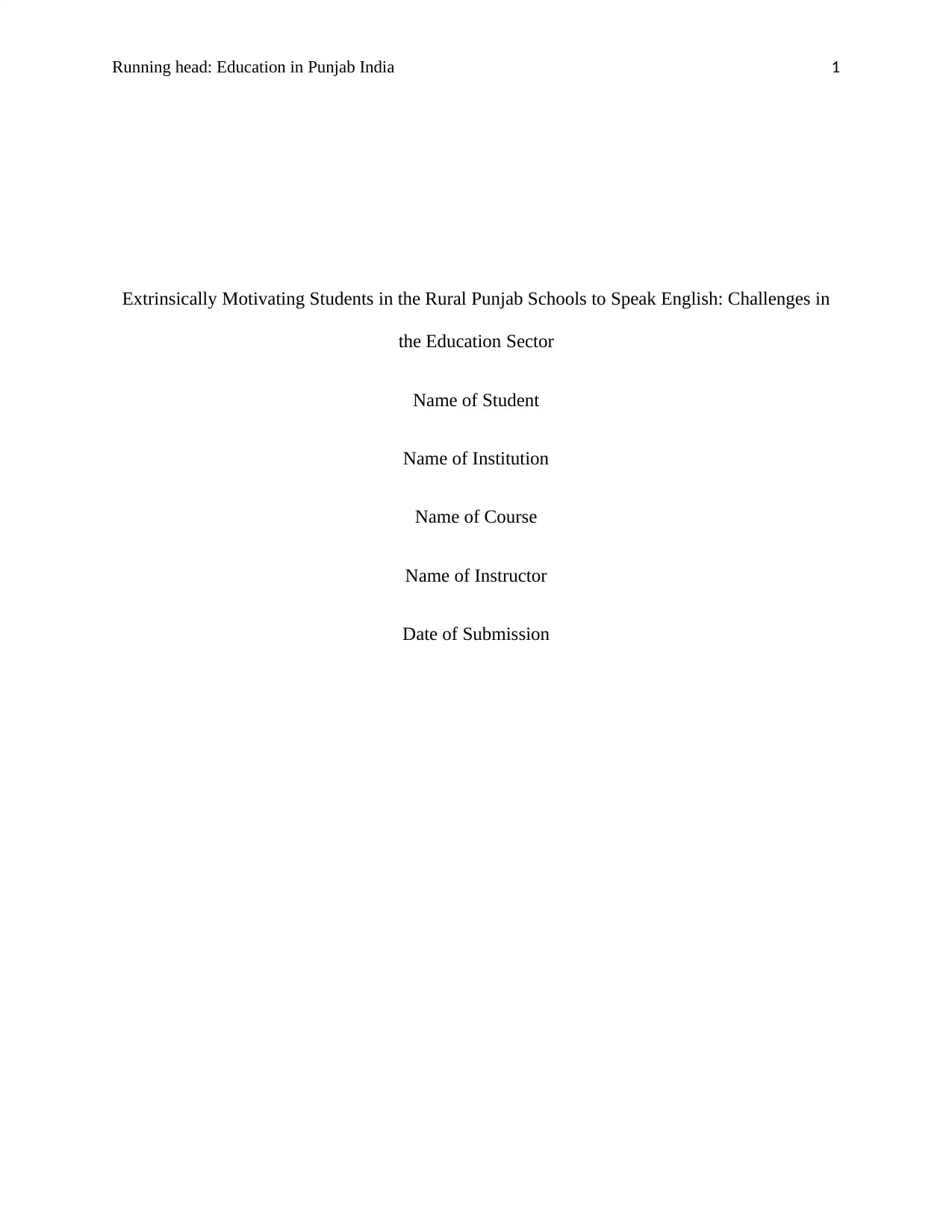
Running head: Education in Punjab India 1
Extrinsically Motivating Students in the Rural Punjab Schools to Speak English: Challenges in
the Education Sector
Name of Student
Name of Institution
Name of Course
Name of Instructor
Date of Submission
Extrinsically Motivating Students in the Rural Punjab Schools to Speak English: Challenges in
the Education Sector
Name of Student
Name of Institution
Name of Course
Name of Instructor
Date of Submission
Paraphrase This Document
Need a fresh take? Get an instant paraphrase of this document with our AI Paraphraser
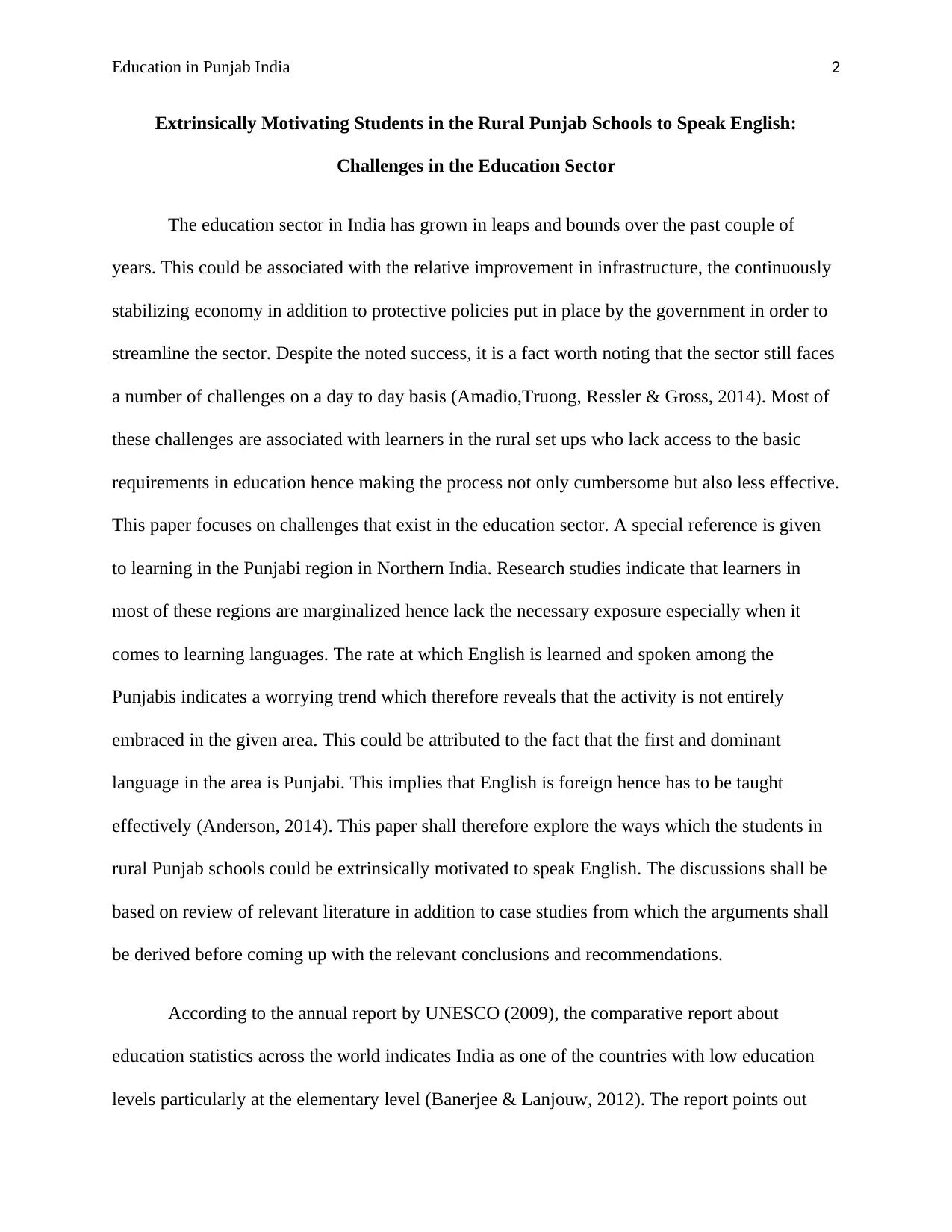
Education in Punjab India 2
Extrinsically Motivating Students in the Rural Punjab Schools to Speak English:
Challenges in the Education Sector
The education sector in India has grown in leaps and bounds over the past couple of
years. This could be associated with the relative improvement in infrastructure, the continuously
stabilizing economy in addition to protective policies put in place by the government in order to
streamline the sector. Despite the noted success, it is a fact worth noting that the sector still faces
a number of challenges on a day to day basis (Amadio,Truong, Ressler & Gross, 2014). Most of
these challenges are associated with learners in the rural set ups who lack access to the basic
requirements in education hence making the process not only cumbersome but also less effective.
This paper focuses on challenges that exist in the education sector. A special reference is given
to learning in the Punjabi region in Northern India. Research studies indicate that learners in
most of these regions are marginalized hence lack the necessary exposure especially when it
comes to learning languages. The rate at which English is learned and spoken among the
Punjabis indicates a worrying trend which therefore reveals that the activity is not entirely
embraced in the given area. This could be attributed to the fact that the first and dominant
language in the area is Punjabi. This implies that English is foreign hence has to be taught
effectively (Anderson, 2014). This paper shall therefore explore the ways which the students in
rural Punjab schools could be extrinsically motivated to speak English. The discussions shall be
based on review of relevant literature in addition to case studies from which the arguments shall
be derived before coming up with the relevant conclusions and recommendations.
According to the annual report by UNESCO (2009), the comparative report about
education statistics across the world indicates India as one of the countries with low education
levels particularly at the elementary level (Banerjee & Lanjouw, 2012). The report points out
Extrinsically Motivating Students in the Rural Punjab Schools to Speak English:
Challenges in the Education Sector
The education sector in India has grown in leaps and bounds over the past couple of
years. This could be associated with the relative improvement in infrastructure, the continuously
stabilizing economy in addition to protective policies put in place by the government in order to
streamline the sector. Despite the noted success, it is a fact worth noting that the sector still faces
a number of challenges on a day to day basis (Amadio,Truong, Ressler & Gross, 2014). Most of
these challenges are associated with learners in the rural set ups who lack access to the basic
requirements in education hence making the process not only cumbersome but also less effective.
This paper focuses on challenges that exist in the education sector. A special reference is given
to learning in the Punjabi region in Northern India. Research studies indicate that learners in
most of these regions are marginalized hence lack the necessary exposure especially when it
comes to learning languages. The rate at which English is learned and spoken among the
Punjabis indicates a worrying trend which therefore reveals that the activity is not entirely
embraced in the given area. This could be attributed to the fact that the first and dominant
language in the area is Punjabi. This implies that English is foreign hence has to be taught
effectively (Anderson, 2014). This paper shall therefore explore the ways which the students in
rural Punjab schools could be extrinsically motivated to speak English. The discussions shall be
based on review of relevant literature in addition to case studies from which the arguments shall
be derived before coming up with the relevant conclusions and recommendations.
According to the annual report by UNESCO (2009), the comparative report about
education statistics across the world indicates India as one of the countries with low education
levels particularly at the elementary level (Banerjee & Lanjouw, 2012). The report points out
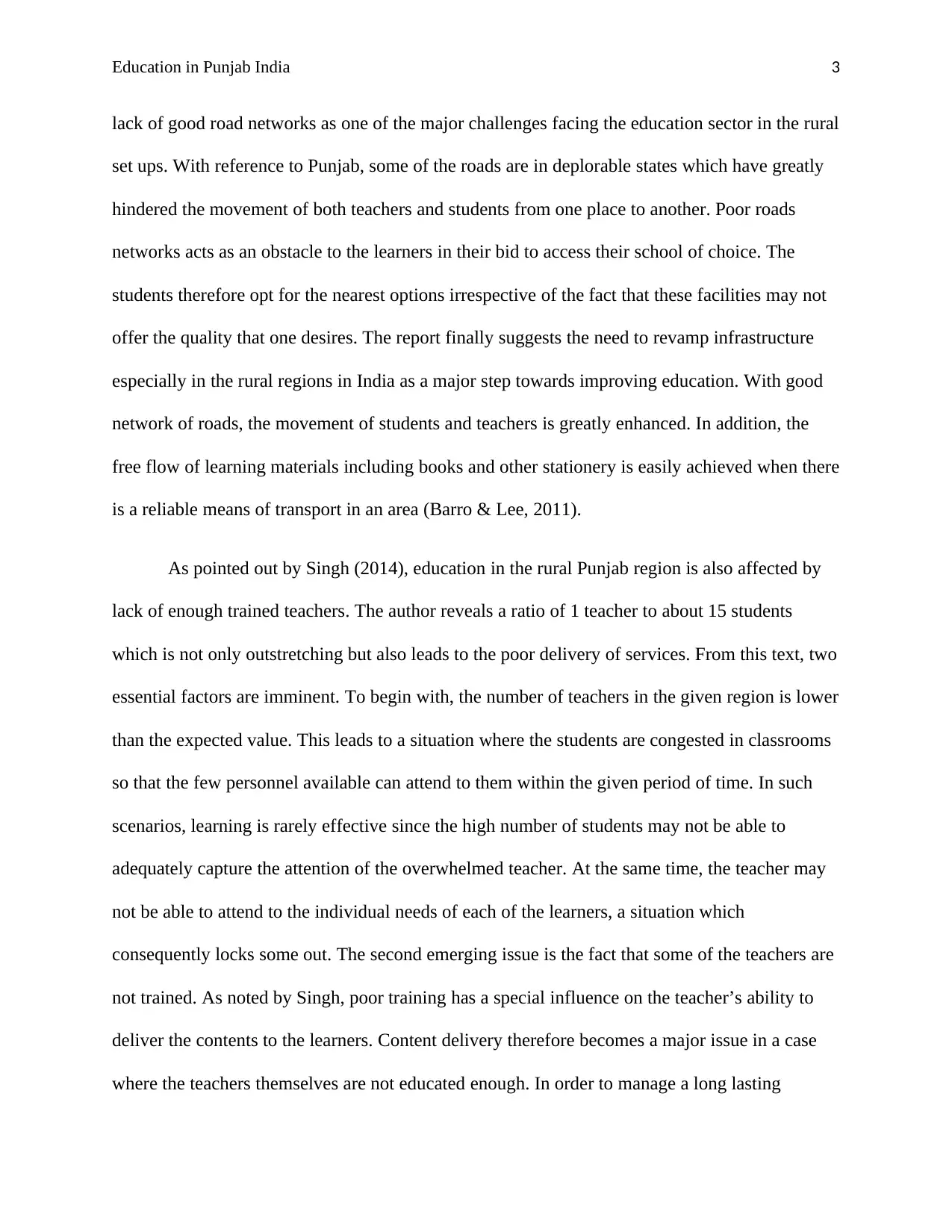
Education in Punjab India 3
lack of good road networks as one of the major challenges facing the education sector in the rural
set ups. With reference to Punjab, some of the roads are in deplorable states which have greatly
hindered the movement of both teachers and students from one place to another. Poor roads
networks acts as an obstacle to the learners in their bid to access their school of choice. The
students therefore opt for the nearest options irrespective of the fact that these facilities may not
offer the quality that one desires. The report finally suggests the need to revamp infrastructure
especially in the rural regions in India as a major step towards improving education. With good
network of roads, the movement of students and teachers is greatly enhanced. In addition, the
free flow of learning materials including books and other stationery is easily achieved when there
is a reliable means of transport in an area (Barro & Lee, 2011).
As pointed out by Singh (2014), education in the rural Punjab region is also affected by
lack of enough trained teachers. The author reveals a ratio of 1 teacher to about 15 students
which is not only outstretching but also leads to the poor delivery of services. From this text, two
essential factors are imminent. To begin with, the number of teachers in the given region is lower
than the expected value. This leads to a situation where the students are congested in classrooms
so that the few personnel available can attend to them within the given period of time. In such
scenarios, learning is rarely effective since the high number of students may not be able to
adequately capture the attention of the overwhelmed teacher. At the same time, the teacher may
not be able to attend to the individual needs of each of the learners, a situation which
consequently locks some out. The second emerging issue is the fact that some of the teachers are
not trained. As noted by Singh, poor training has a special influence on the teacher’s ability to
deliver the contents to the learners. Content delivery therefore becomes a major issue in a case
where the teachers themselves are not educated enough. In order to manage a long lasting
lack of good road networks as one of the major challenges facing the education sector in the rural
set ups. With reference to Punjab, some of the roads are in deplorable states which have greatly
hindered the movement of both teachers and students from one place to another. Poor roads
networks acts as an obstacle to the learners in their bid to access their school of choice. The
students therefore opt for the nearest options irrespective of the fact that these facilities may not
offer the quality that one desires. The report finally suggests the need to revamp infrastructure
especially in the rural regions in India as a major step towards improving education. With good
network of roads, the movement of students and teachers is greatly enhanced. In addition, the
free flow of learning materials including books and other stationery is easily achieved when there
is a reliable means of transport in an area (Barro & Lee, 2011).
As pointed out by Singh (2014), education in the rural Punjab region is also affected by
lack of enough trained teachers. The author reveals a ratio of 1 teacher to about 15 students
which is not only outstretching but also leads to the poor delivery of services. From this text, two
essential factors are imminent. To begin with, the number of teachers in the given region is lower
than the expected value. This leads to a situation where the students are congested in classrooms
so that the few personnel available can attend to them within the given period of time. In such
scenarios, learning is rarely effective since the high number of students may not be able to
adequately capture the attention of the overwhelmed teacher. At the same time, the teacher may
not be able to attend to the individual needs of each of the learners, a situation which
consequently locks some out. The second emerging issue is the fact that some of the teachers are
not trained. As noted by Singh, poor training has a special influence on the teacher’s ability to
deliver the contents to the learners. Content delivery therefore becomes a major issue in a case
where the teachers themselves are not educated enough. In order to manage a long lasting
⊘ This is a preview!⊘
Do you want full access?
Subscribe today to unlock all pages.

Trusted by 1+ million students worldwide
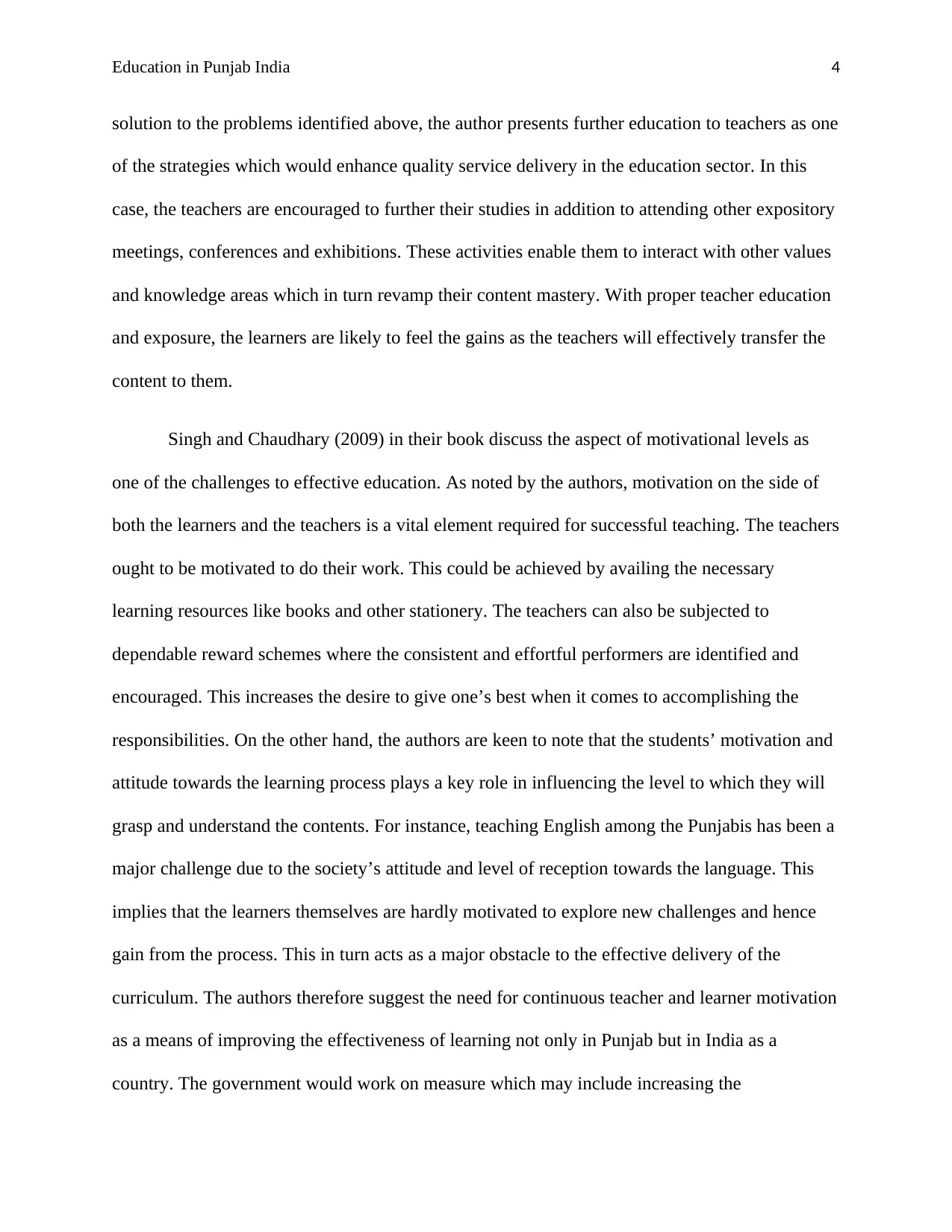
Education in Punjab India 4
solution to the problems identified above, the author presents further education to teachers as one
of the strategies which would enhance quality service delivery in the education sector. In this
case, the teachers are encouraged to further their studies in addition to attending other expository
meetings, conferences and exhibitions. These activities enable them to interact with other values
and knowledge areas which in turn revamp their content mastery. With proper teacher education
and exposure, the learners are likely to feel the gains as the teachers will effectively transfer the
content to them.
Singh and Chaudhary (2009) in their book discuss the aspect of motivational levels as
one of the challenges to effective education. As noted by the authors, motivation on the side of
both the learners and the teachers is a vital element required for successful teaching. The teachers
ought to be motivated to do their work. This could be achieved by availing the necessary
learning resources like books and other stationery. The teachers can also be subjected to
dependable reward schemes where the consistent and effortful performers are identified and
encouraged. This increases the desire to give one’s best when it comes to accomplishing the
responsibilities. On the other hand, the authors are keen to note that the students’ motivation and
attitude towards the learning process plays a key role in influencing the level to which they will
grasp and understand the contents. For instance, teaching English among the Punjabis has been a
major challenge due to the society’s attitude and level of reception towards the language. This
implies that the learners themselves are hardly motivated to explore new challenges and hence
gain from the process. This in turn acts as a major obstacle to the effective delivery of the
curriculum. The authors therefore suggest the need for continuous teacher and learner motivation
as a means of improving the effectiveness of learning not only in Punjab but in India as a
country. The government would work on measure which may include increasing the
solution to the problems identified above, the author presents further education to teachers as one
of the strategies which would enhance quality service delivery in the education sector. In this
case, the teachers are encouraged to further their studies in addition to attending other expository
meetings, conferences and exhibitions. These activities enable them to interact with other values
and knowledge areas which in turn revamp their content mastery. With proper teacher education
and exposure, the learners are likely to feel the gains as the teachers will effectively transfer the
content to them.
Singh and Chaudhary (2009) in their book discuss the aspect of motivational levels as
one of the challenges to effective education. As noted by the authors, motivation on the side of
both the learners and the teachers is a vital element required for successful teaching. The teachers
ought to be motivated to do their work. This could be achieved by availing the necessary
learning resources like books and other stationery. The teachers can also be subjected to
dependable reward schemes where the consistent and effortful performers are identified and
encouraged. This increases the desire to give one’s best when it comes to accomplishing the
responsibilities. On the other hand, the authors are keen to note that the students’ motivation and
attitude towards the learning process plays a key role in influencing the level to which they will
grasp and understand the contents. For instance, teaching English among the Punjabis has been a
major challenge due to the society’s attitude and level of reception towards the language. This
implies that the learners themselves are hardly motivated to explore new challenges and hence
gain from the process. This in turn acts as a major obstacle to the effective delivery of the
curriculum. The authors therefore suggest the need for continuous teacher and learner motivation
as a means of improving the effectiveness of learning not only in Punjab but in India as a
country. The government would work on measure which may include increasing the
Paraphrase This Document
Need a fresh take? Get an instant paraphrase of this document with our AI Paraphraser
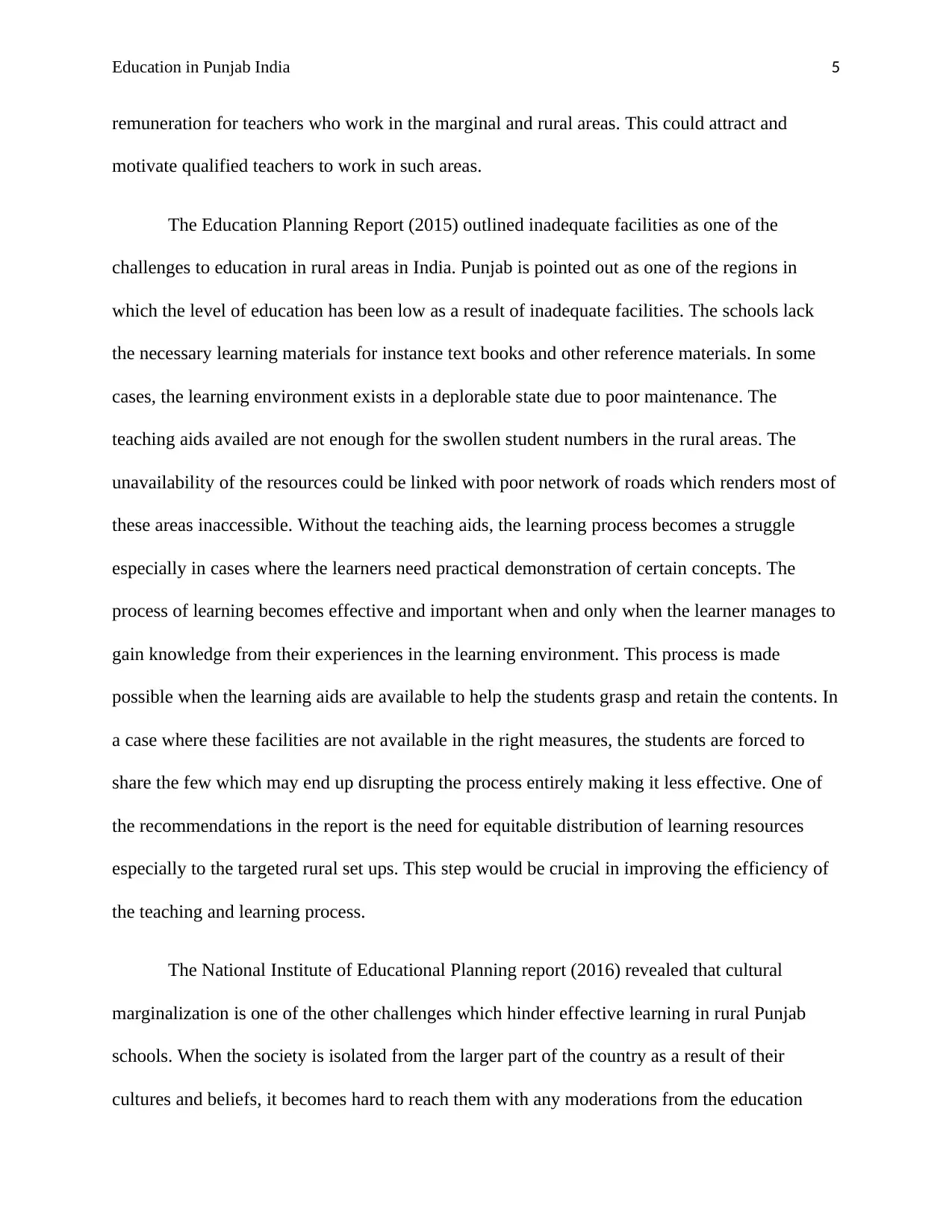
Education in Punjab India 5
remuneration for teachers who work in the marginal and rural areas. This could attract and
motivate qualified teachers to work in such areas.
The Education Planning Report (2015) outlined inadequate facilities as one of the
challenges to education in rural areas in India. Punjab is pointed out as one of the regions in
which the level of education has been low as a result of inadequate facilities. The schools lack
the necessary learning materials for instance text books and other reference materials. In some
cases, the learning environment exists in a deplorable state due to poor maintenance. The
teaching aids availed are not enough for the swollen student numbers in the rural areas. The
unavailability of the resources could be linked with poor network of roads which renders most of
these areas inaccessible. Without the teaching aids, the learning process becomes a struggle
especially in cases where the learners need practical demonstration of certain concepts. The
process of learning becomes effective and important when and only when the learner manages to
gain knowledge from their experiences in the learning environment. This process is made
possible when the learning aids are available to help the students grasp and retain the contents. In
a case where these facilities are not available in the right measures, the students are forced to
share the few which may end up disrupting the process entirely making it less effective. One of
the recommendations in the report is the need for equitable distribution of learning resources
especially to the targeted rural set ups. This step would be crucial in improving the efficiency of
the teaching and learning process.
The National Institute of Educational Planning report (2016) revealed that cultural
marginalization is one of the other challenges which hinder effective learning in rural Punjab
schools. When the society is isolated from the larger part of the country as a result of their
cultures and beliefs, it becomes hard to reach them with any moderations from the education
remuneration for teachers who work in the marginal and rural areas. This could attract and
motivate qualified teachers to work in such areas.
The Education Planning Report (2015) outlined inadequate facilities as one of the
challenges to education in rural areas in India. Punjab is pointed out as one of the regions in
which the level of education has been low as a result of inadequate facilities. The schools lack
the necessary learning materials for instance text books and other reference materials. In some
cases, the learning environment exists in a deplorable state due to poor maintenance. The
teaching aids availed are not enough for the swollen student numbers in the rural areas. The
unavailability of the resources could be linked with poor network of roads which renders most of
these areas inaccessible. Without the teaching aids, the learning process becomes a struggle
especially in cases where the learners need practical demonstration of certain concepts. The
process of learning becomes effective and important when and only when the learner manages to
gain knowledge from their experiences in the learning environment. This process is made
possible when the learning aids are available to help the students grasp and retain the contents. In
a case where these facilities are not available in the right measures, the students are forced to
share the few which may end up disrupting the process entirely making it less effective. One of
the recommendations in the report is the need for equitable distribution of learning resources
especially to the targeted rural set ups. This step would be crucial in improving the efficiency of
the teaching and learning process.
The National Institute of Educational Planning report (2016) revealed that cultural
marginalization is one of the other challenges which hinder effective learning in rural Punjab
schools. When the society is isolated from the larger part of the country as a result of their
cultures and beliefs, it becomes hard to reach them with any moderations from the education
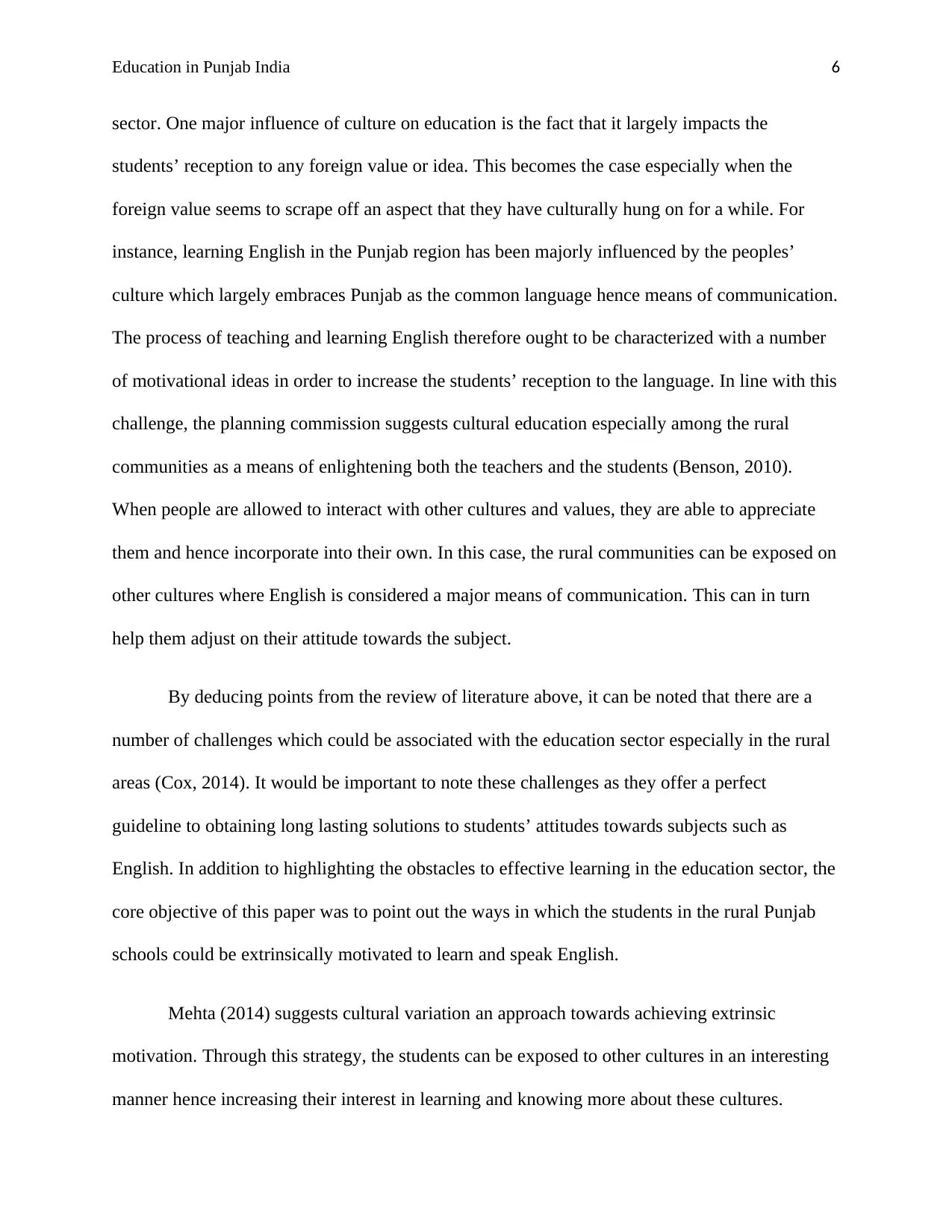
Education in Punjab India 6
sector. One major influence of culture on education is the fact that it largely impacts the
students’ reception to any foreign value or idea. This becomes the case especially when the
foreign value seems to scrape off an aspect that they have culturally hung on for a while. For
instance, learning English in the Punjab region has been majorly influenced by the peoples’
culture which largely embraces Punjab as the common language hence means of communication.
The process of teaching and learning English therefore ought to be characterized with a number
of motivational ideas in order to increase the students’ reception to the language. In line with this
challenge, the planning commission suggests cultural education especially among the rural
communities as a means of enlightening both the teachers and the students (Benson, 2010).
When people are allowed to interact with other cultures and values, they are able to appreciate
them and hence incorporate into their own. In this case, the rural communities can be exposed on
other cultures where English is considered a major means of communication. This can in turn
help them adjust on their attitude towards the subject.
By deducing points from the review of literature above, it can be noted that there are a
number of challenges which could be associated with the education sector especially in the rural
areas (Cox, 2014). It would be important to note these challenges as they offer a perfect
guideline to obtaining long lasting solutions to students’ attitudes towards subjects such as
English. In addition to highlighting the obstacles to effective learning in the education sector, the
core objective of this paper was to point out the ways in which the students in the rural Punjab
schools could be extrinsically motivated to learn and speak English.
Mehta (2014) suggests cultural variation an approach towards achieving extrinsic
motivation. Through this strategy, the students can be exposed to other cultures in an interesting
manner hence increasing their interest in learning and knowing more about these cultures.
sector. One major influence of culture on education is the fact that it largely impacts the
students’ reception to any foreign value or idea. This becomes the case especially when the
foreign value seems to scrape off an aspect that they have culturally hung on for a while. For
instance, learning English in the Punjab region has been majorly influenced by the peoples’
culture which largely embraces Punjab as the common language hence means of communication.
The process of teaching and learning English therefore ought to be characterized with a number
of motivational ideas in order to increase the students’ reception to the language. In line with this
challenge, the planning commission suggests cultural education especially among the rural
communities as a means of enlightening both the teachers and the students (Benson, 2010).
When people are allowed to interact with other cultures and values, they are able to appreciate
them and hence incorporate into their own. In this case, the rural communities can be exposed on
other cultures where English is considered a major means of communication. This can in turn
help them adjust on their attitude towards the subject.
By deducing points from the review of literature above, it can be noted that there are a
number of challenges which could be associated with the education sector especially in the rural
areas (Cox, 2014). It would be important to note these challenges as they offer a perfect
guideline to obtaining long lasting solutions to students’ attitudes towards subjects such as
English. In addition to highlighting the obstacles to effective learning in the education sector, the
core objective of this paper was to point out the ways in which the students in the rural Punjab
schools could be extrinsically motivated to learn and speak English.
Mehta (2014) suggests cultural variation an approach towards achieving extrinsic
motivation. Through this strategy, the students can be exposed to other cultures in an interesting
manner hence increasing their interest in learning and knowing more about these cultures.
⊘ This is a preview!⊘
Do you want full access?
Subscribe today to unlock all pages.

Trusted by 1+ million students worldwide
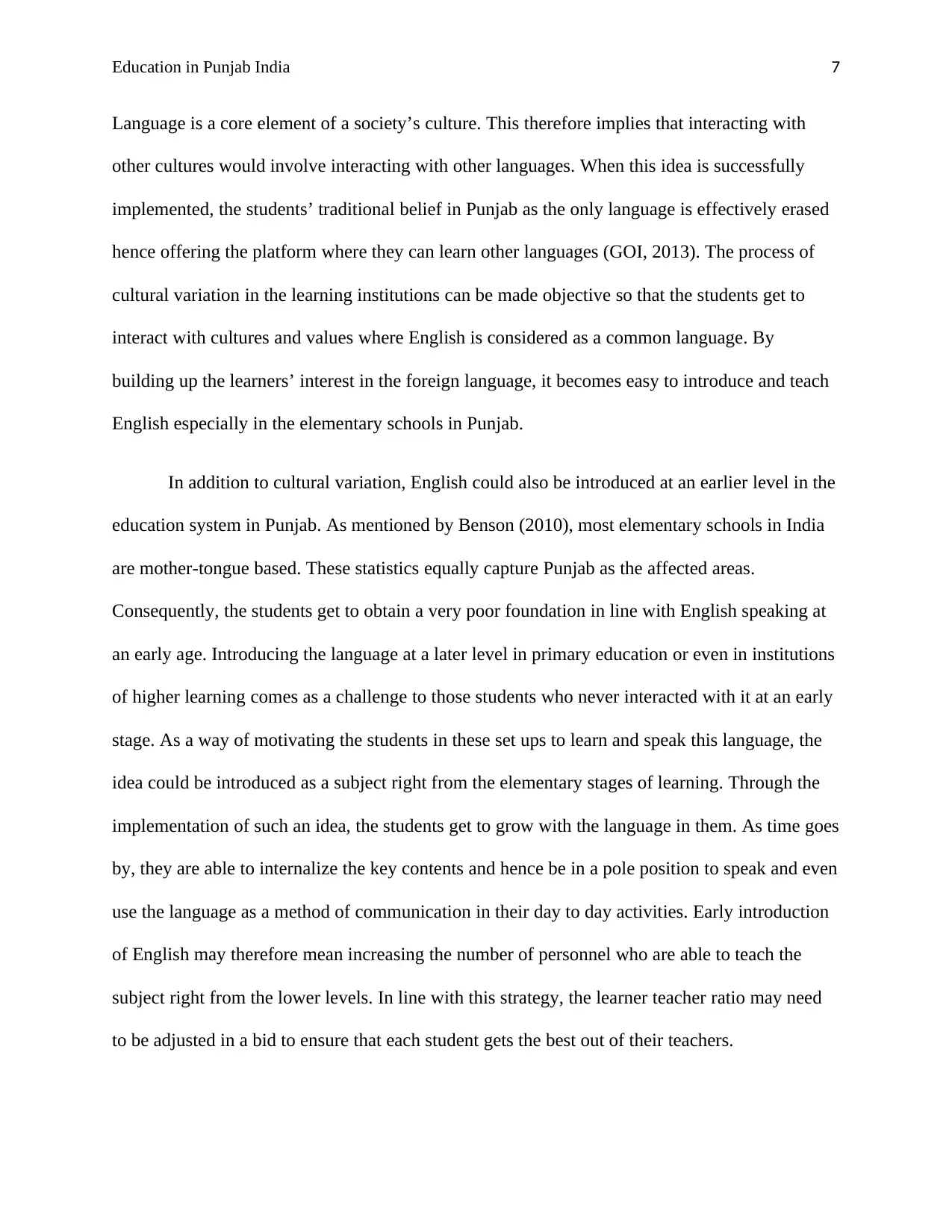
Education in Punjab India 7
Language is a core element of a society’s culture. This therefore implies that interacting with
other cultures would involve interacting with other languages. When this idea is successfully
implemented, the students’ traditional belief in Punjab as the only language is effectively erased
hence offering the platform where they can learn other languages (GOI, 2013). The process of
cultural variation in the learning institutions can be made objective so that the students get to
interact with cultures and values where English is considered as a common language. By
building up the learners’ interest in the foreign language, it becomes easy to introduce and teach
English especially in the elementary schools in Punjab.
In addition to cultural variation, English could also be introduced at an earlier level in the
education system in Punjab. As mentioned by Benson (2010), most elementary schools in India
are mother-tongue based. These statistics equally capture Punjab as the affected areas.
Consequently, the students get to obtain a very poor foundation in line with English speaking at
an early age. Introducing the language at a later level in primary education or even in institutions
of higher learning comes as a challenge to those students who never interacted with it at an early
stage. As a way of motivating the students in these set ups to learn and speak this language, the
idea could be introduced as a subject right from the elementary stages of learning. Through the
implementation of such an idea, the students get to grow with the language in them. As time goes
by, they are able to internalize the key contents and hence be in a pole position to speak and even
use the language as a method of communication in their day to day activities. Early introduction
of English may therefore mean increasing the number of personnel who are able to teach the
subject right from the lower levels. In line with this strategy, the learner teacher ratio may need
to be adjusted in a bid to ensure that each student gets the best out of their teachers.
Language is a core element of a society’s culture. This therefore implies that interacting with
other cultures would involve interacting with other languages. When this idea is successfully
implemented, the students’ traditional belief in Punjab as the only language is effectively erased
hence offering the platform where they can learn other languages (GOI, 2013). The process of
cultural variation in the learning institutions can be made objective so that the students get to
interact with cultures and values where English is considered as a common language. By
building up the learners’ interest in the foreign language, it becomes easy to introduce and teach
English especially in the elementary schools in Punjab.
In addition to cultural variation, English could also be introduced at an earlier level in the
education system in Punjab. As mentioned by Benson (2010), most elementary schools in India
are mother-tongue based. These statistics equally capture Punjab as the affected areas.
Consequently, the students get to obtain a very poor foundation in line with English speaking at
an early age. Introducing the language at a later level in primary education or even in institutions
of higher learning comes as a challenge to those students who never interacted with it at an early
stage. As a way of motivating the students in these set ups to learn and speak this language, the
idea could be introduced as a subject right from the elementary stages of learning. Through the
implementation of such an idea, the students get to grow with the language in them. As time goes
by, they are able to internalize the key contents and hence be in a pole position to speak and even
use the language as a method of communication in their day to day activities. Early introduction
of English may therefore mean increasing the number of personnel who are able to teach the
subject right from the lower levels. In line with this strategy, the learner teacher ratio may need
to be adjusted in a bid to ensure that each student gets the best out of their teachers.
Paraphrase This Document
Need a fresh take? Get an instant paraphrase of this document with our AI Paraphraser
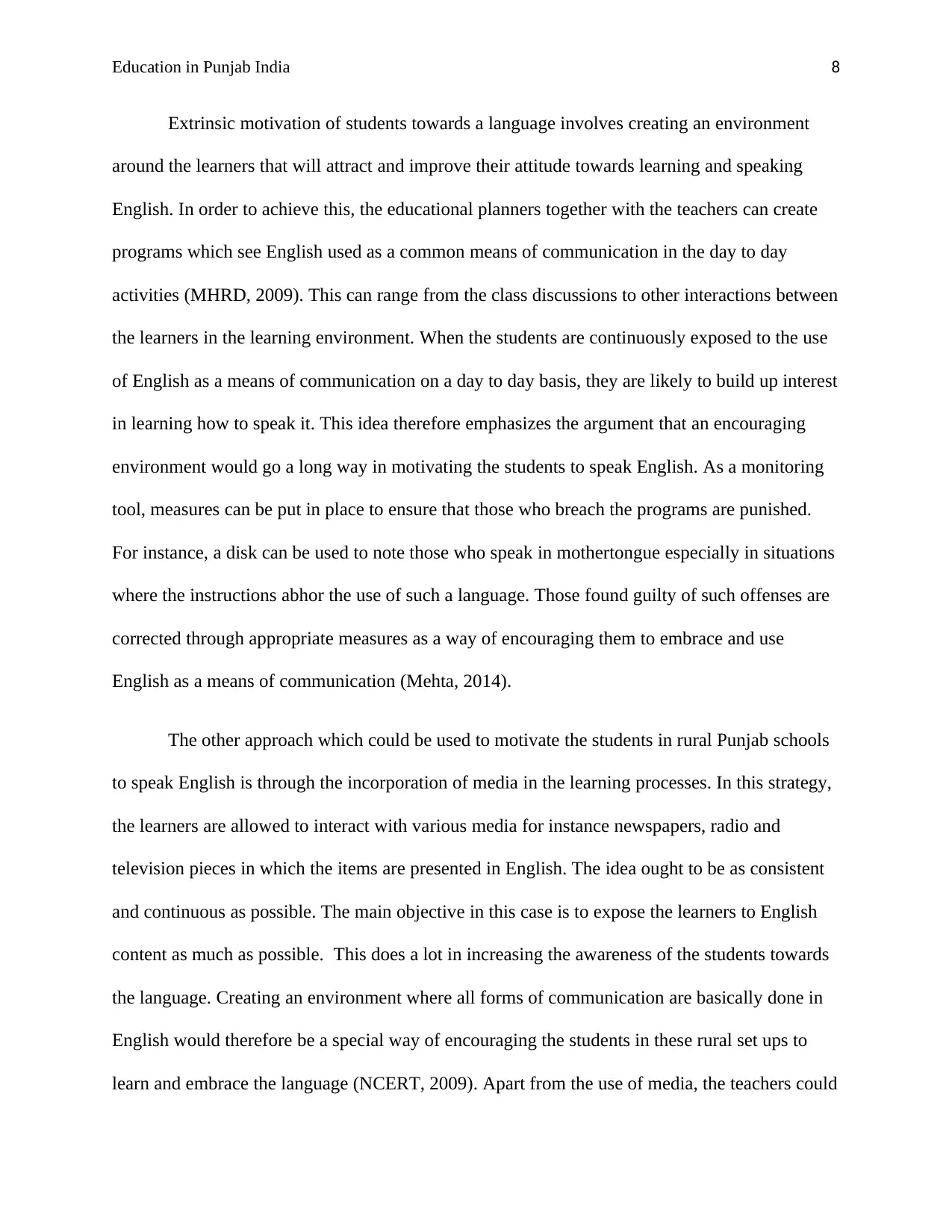
Education in Punjab India 8
Extrinsic motivation of students towards a language involves creating an environment
around the learners that will attract and improve their attitude towards learning and speaking
English. In order to achieve this, the educational planners together with the teachers can create
programs which see English used as a common means of communication in the day to day
activities (MHRD, 2009). This can range from the class discussions to other interactions between
the learners in the learning environment. When the students are continuously exposed to the use
of English as a means of communication on a day to day basis, they are likely to build up interest
in learning how to speak it. This idea therefore emphasizes the argument that an encouraging
environment would go a long way in motivating the students to speak English. As a monitoring
tool, measures can be put in place to ensure that those who breach the programs are punished.
For instance, a disk can be used to note those who speak in mothertongue especially in situations
where the instructions abhor the use of such a language. Those found guilty of such offenses are
corrected through appropriate measures as a way of encouraging them to embrace and use
English as a means of communication (Mehta, 2014).
The other approach which could be used to motivate the students in rural Punjab schools
to speak English is through the incorporation of media in the learning processes. In this strategy,
the learners are allowed to interact with various media for instance newspapers, radio and
television pieces in which the items are presented in English. The idea ought to be as consistent
and continuous as possible. The main objective in this case is to expose the learners to English
content as much as possible. This does a lot in increasing the awareness of the students towards
the language. Creating an environment where all forms of communication are basically done in
English would therefore be a special way of encouraging the students in these rural set ups to
learn and embrace the language (NCERT, 2009). Apart from the use of media, the teachers could
Extrinsic motivation of students towards a language involves creating an environment
around the learners that will attract and improve their attitude towards learning and speaking
English. In order to achieve this, the educational planners together with the teachers can create
programs which see English used as a common means of communication in the day to day
activities (MHRD, 2009). This can range from the class discussions to other interactions between
the learners in the learning environment. When the students are continuously exposed to the use
of English as a means of communication on a day to day basis, they are likely to build up interest
in learning how to speak it. This idea therefore emphasizes the argument that an encouraging
environment would go a long way in motivating the students to speak English. As a monitoring
tool, measures can be put in place to ensure that those who breach the programs are punished.
For instance, a disk can be used to note those who speak in mothertongue especially in situations
where the instructions abhor the use of such a language. Those found guilty of such offenses are
corrected through appropriate measures as a way of encouraging them to embrace and use
English as a means of communication (Mehta, 2014).
The other approach which could be used to motivate the students in rural Punjab schools
to speak English is through the incorporation of media in the learning processes. In this strategy,
the learners are allowed to interact with various media for instance newspapers, radio and
television pieces in which the items are presented in English. The idea ought to be as consistent
and continuous as possible. The main objective in this case is to expose the learners to English
content as much as possible. This does a lot in increasing the awareness of the students towards
the language. Creating an environment where all forms of communication are basically done in
English would therefore be a special way of encouraging the students in these rural set ups to
learn and embrace the language (NCERT, 2009). Apart from the use of media, the teachers could
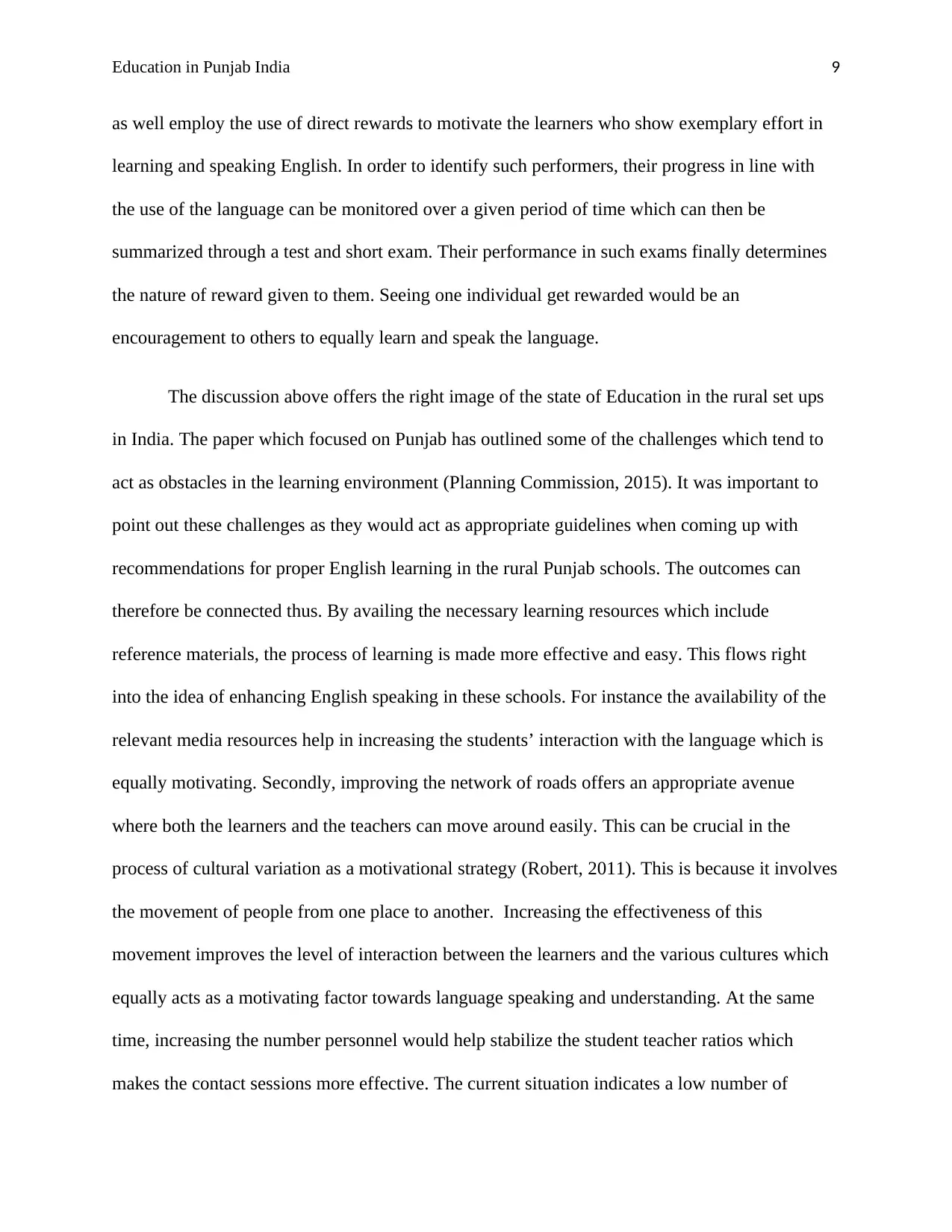
Education in Punjab India 9
as well employ the use of direct rewards to motivate the learners who show exemplary effort in
learning and speaking English. In order to identify such performers, their progress in line with
the use of the language can be monitored over a given period of time which can then be
summarized through a test and short exam. Their performance in such exams finally determines
the nature of reward given to them. Seeing one individual get rewarded would be an
encouragement to others to equally learn and speak the language.
The discussion above offers the right image of the state of Education in the rural set ups
in India. The paper which focused on Punjab has outlined some of the challenges which tend to
act as obstacles in the learning environment (Planning Commission, 2015). It was important to
point out these challenges as they would act as appropriate guidelines when coming up with
recommendations for proper English learning in the rural Punjab schools. The outcomes can
therefore be connected thus. By availing the necessary learning resources which include
reference materials, the process of learning is made more effective and easy. This flows right
into the idea of enhancing English speaking in these schools. For instance the availability of the
relevant media resources help in increasing the students’ interaction with the language which is
equally motivating. Secondly, improving the network of roads offers an appropriate avenue
where both the learners and the teachers can move around easily. This can be crucial in the
process of cultural variation as a motivational strategy (Robert, 2011). This is because it involves
the movement of people from one place to another. Increasing the effectiveness of this
movement improves the level of interaction between the learners and the various cultures which
equally acts as a motivating factor towards language speaking and understanding. At the same
time, increasing the number personnel would help stabilize the student teacher ratios which
makes the contact sessions more effective. The current situation indicates a low number of
as well employ the use of direct rewards to motivate the learners who show exemplary effort in
learning and speaking English. In order to identify such performers, their progress in line with
the use of the language can be monitored over a given period of time which can then be
summarized through a test and short exam. Their performance in such exams finally determines
the nature of reward given to them. Seeing one individual get rewarded would be an
encouragement to others to equally learn and speak the language.
The discussion above offers the right image of the state of Education in the rural set ups
in India. The paper which focused on Punjab has outlined some of the challenges which tend to
act as obstacles in the learning environment (Planning Commission, 2015). It was important to
point out these challenges as they would act as appropriate guidelines when coming up with
recommendations for proper English learning in the rural Punjab schools. The outcomes can
therefore be connected thus. By availing the necessary learning resources which include
reference materials, the process of learning is made more effective and easy. This flows right
into the idea of enhancing English speaking in these schools. For instance the availability of the
relevant media resources help in increasing the students’ interaction with the language which is
equally motivating. Secondly, improving the network of roads offers an appropriate avenue
where both the learners and the teachers can move around easily. This can be crucial in the
process of cultural variation as a motivational strategy (Robert, 2011). This is because it involves
the movement of people from one place to another. Increasing the effectiveness of this
movement improves the level of interaction between the learners and the various cultures which
equally acts as a motivating factor towards language speaking and understanding. At the same
time, increasing the number personnel would help stabilize the student teacher ratios which
makes the contact sessions more effective. The current situation indicates a low number of
⊘ This is a preview!⊘
Do you want full access?
Subscribe today to unlock all pages.

Trusted by 1+ million students worldwide
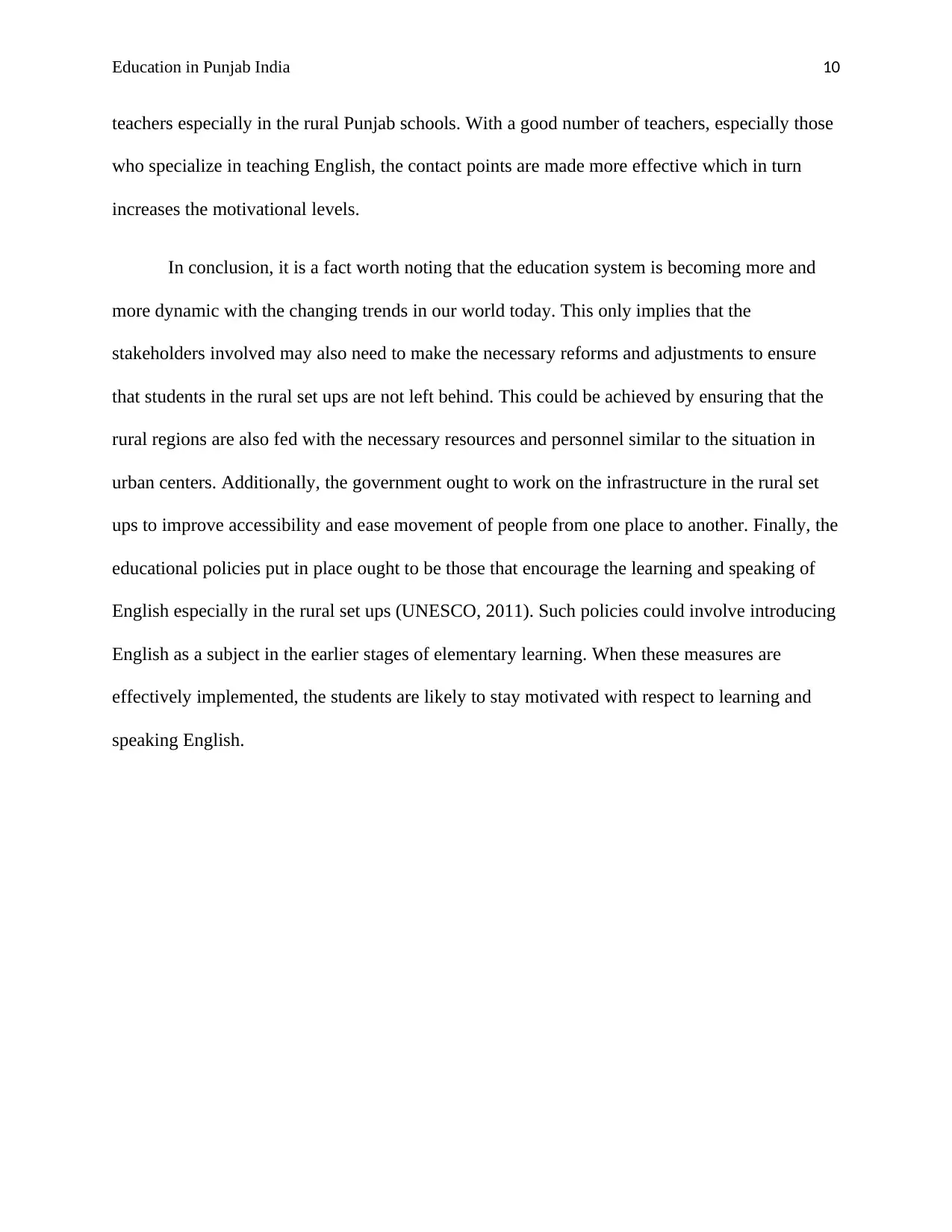
Education in Punjab India 10
teachers especially in the rural Punjab schools. With a good number of teachers, especially those
who specialize in teaching English, the contact points are made more effective which in turn
increases the motivational levels.
In conclusion, it is a fact worth noting that the education system is becoming more and
more dynamic with the changing trends in our world today. This only implies that the
stakeholders involved may also need to make the necessary reforms and adjustments to ensure
that students in the rural set ups are not left behind. This could be achieved by ensuring that the
rural regions are also fed with the necessary resources and personnel similar to the situation in
urban centers. Additionally, the government ought to work on the infrastructure in the rural set
ups to improve accessibility and ease movement of people from one place to another. Finally, the
educational policies put in place ought to be those that encourage the learning and speaking of
English especially in the rural set ups (UNESCO, 2011). Such policies could involve introducing
English as a subject in the earlier stages of elementary learning. When these measures are
effectively implemented, the students are likely to stay motivated with respect to learning and
speaking English.
teachers especially in the rural Punjab schools. With a good number of teachers, especially those
who specialize in teaching English, the contact points are made more effective which in turn
increases the motivational levels.
In conclusion, it is a fact worth noting that the education system is becoming more and
more dynamic with the changing trends in our world today. This only implies that the
stakeholders involved may also need to make the necessary reforms and adjustments to ensure
that students in the rural set ups are not left behind. This could be achieved by ensuring that the
rural regions are also fed with the necessary resources and personnel similar to the situation in
urban centers. Additionally, the government ought to work on the infrastructure in the rural set
ups to improve accessibility and ease movement of people from one place to another. Finally, the
educational policies put in place ought to be those that encourage the learning and speaking of
English especially in the rural set ups (UNESCO, 2011). Such policies could involve introducing
English as a subject in the earlier stages of elementary learning. When these measures are
effectively implemented, the students are likely to stay motivated with respect to learning and
speaking English.
Paraphrase This Document
Need a fresh take? Get an instant paraphrase of this document with our AI Paraphraser
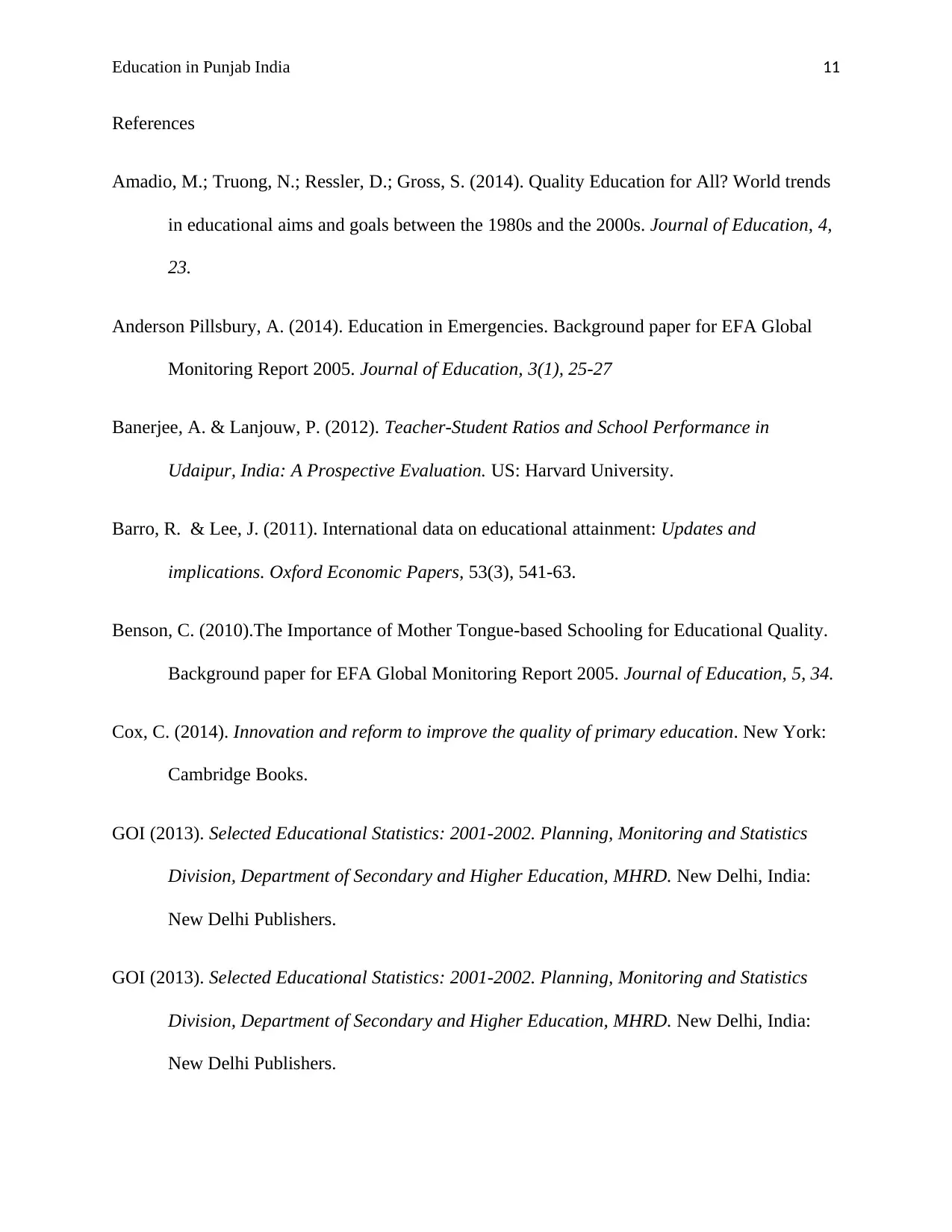
Education in Punjab India 11
References
Amadio, M.; Truong, N.; Ressler, D.; Gross, S. (2014). Quality Education for All? World trends
in educational aims and goals between the 1980s and the 2000s. Journal of Education, 4,
23.
Anderson Pillsbury, A. (2014). Education in Emergencies. Background paper for EFA Global
Monitoring Report 2005. Journal of Education, 3(1), 25-27
Banerjee, A. & Lanjouw, P. (2012). Teacher-Student Ratios and School Performance in
Udaipur, India: A Prospective Evaluation. US: Harvard University.
Barro, R. & Lee, J. (2011). International data on educational attainment: Updates and
implications. Oxford Economic Papers, 53(3), 541-63.
Benson, C. (2010).The Importance of Mother Tongue-based Schooling for Educational Quality.
Background paper for EFA Global Monitoring Report 2005. Journal of Education, 5, 34.
Cox, C. (2014). Innovation and reform to improve the quality of primary education. New York:
Cambridge Books.
GOI (2013). Selected Educational Statistics: 2001-2002. Planning, Monitoring and Statistics
Division, Department of Secondary and Higher Education, MHRD. New Delhi, India:
New Delhi Publishers.
GOI (2013). Selected Educational Statistics: 2001-2002. Planning, Monitoring and Statistics
Division, Department of Secondary and Higher Education, MHRD. New Delhi, India:
New Delhi Publishers.
References
Amadio, M.; Truong, N.; Ressler, D.; Gross, S. (2014). Quality Education for All? World trends
in educational aims and goals between the 1980s and the 2000s. Journal of Education, 4,
23.
Anderson Pillsbury, A. (2014). Education in Emergencies. Background paper for EFA Global
Monitoring Report 2005. Journal of Education, 3(1), 25-27
Banerjee, A. & Lanjouw, P. (2012). Teacher-Student Ratios and School Performance in
Udaipur, India: A Prospective Evaluation. US: Harvard University.
Barro, R. & Lee, J. (2011). International data on educational attainment: Updates and
implications. Oxford Economic Papers, 53(3), 541-63.
Benson, C. (2010).The Importance of Mother Tongue-based Schooling for Educational Quality.
Background paper for EFA Global Monitoring Report 2005. Journal of Education, 5, 34.
Cox, C. (2014). Innovation and reform to improve the quality of primary education. New York:
Cambridge Books.
GOI (2013). Selected Educational Statistics: 2001-2002. Planning, Monitoring and Statistics
Division, Department of Secondary and Higher Education, MHRD. New Delhi, India:
New Delhi Publishers.
GOI (2013). Selected Educational Statistics: 2001-2002. Planning, Monitoring and Statistics
Division, Department of Secondary and Higher Education, MHRD. New Delhi, India:
New Delhi Publishers.
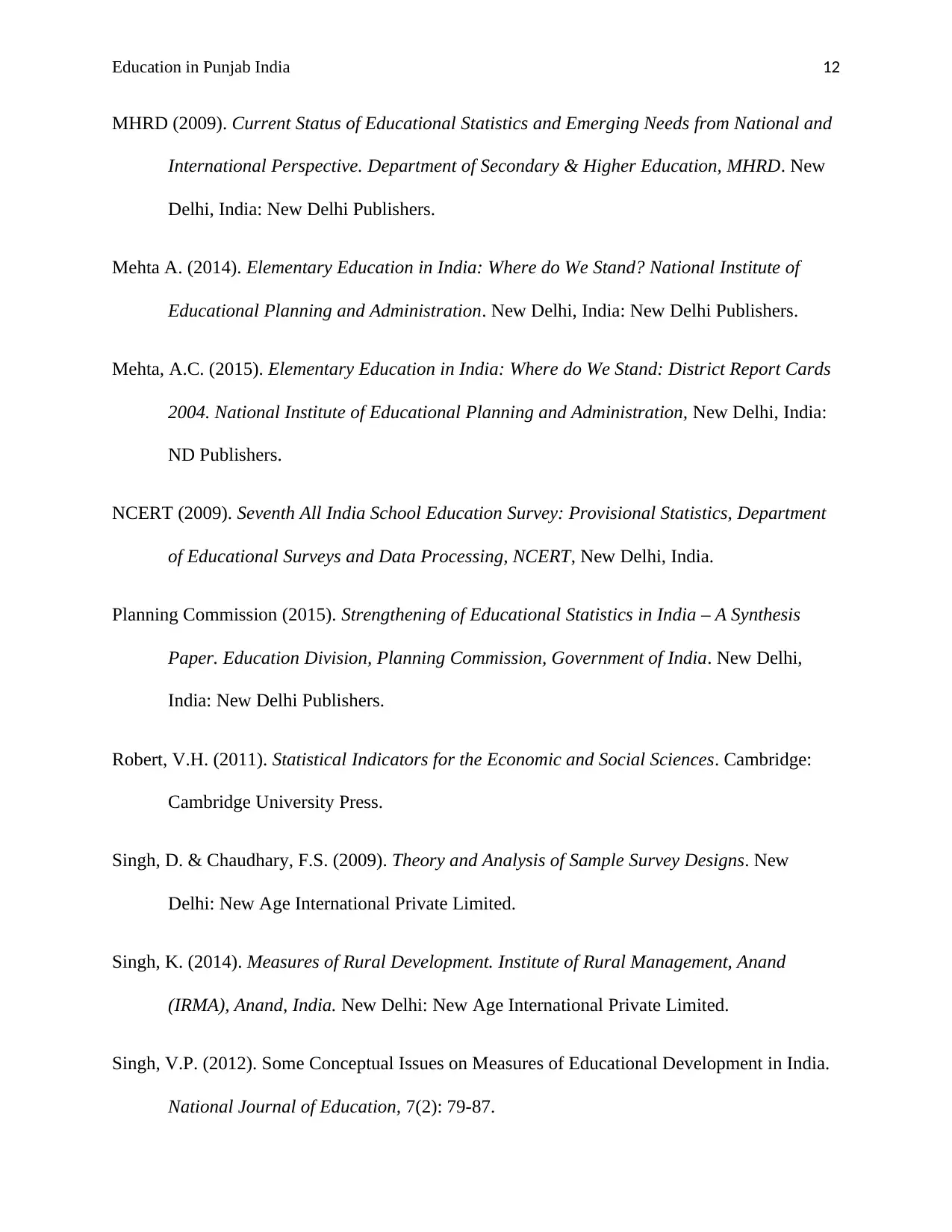
Education in Punjab India 12
MHRD (2009). Current Status of Educational Statistics and Emerging Needs from National and
International Perspective. Department of Secondary & Higher Education, MHRD. New
Delhi, India: New Delhi Publishers.
Mehta A. (2014). Elementary Education in India: Where do We Stand? National Institute of
Educational Planning and Administration. New Delhi, India: New Delhi Publishers.
Mehta, A.C. (2015). Elementary Education in India: Where do We Stand: District Report Cards
2004. National Institute of Educational Planning and Administration, New Delhi, India:
ND Publishers.
NCERT (2009). Seventh All India School Education Survey: Provisional Statistics, Department
of Educational Surveys and Data Processing, NCERT, New Delhi, India.
Planning Commission (2015). Strengthening of Educational Statistics in India – A Synthesis
Paper. Education Division, Planning Commission, Government of India. New Delhi,
India: New Delhi Publishers.
Robert, V.H. (2011). Statistical Indicators for the Economic and Social Sciences. Cambridge:
Cambridge University Press.
Singh, D. & Chaudhary, F.S. (2009). Theory and Analysis of Sample Survey Designs. New
Delhi: New Age International Private Limited.
Singh, K. (2014). Measures of Rural Development. Institute of Rural Management, Anand
(IRMA), Anand, India. New Delhi: New Age International Private Limited.
Singh, V.P. (2012). Some Conceptual Issues on Measures of Educational Development in India.
National Journal of Education, 7(2): 79-87.
MHRD (2009). Current Status of Educational Statistics and Emerging Needs from National and
International Perspective. Department of Secondary & Higher Education, MHRD. New
Delhi, India: New Delhi Publishers.
Mehta A. (2014). Elementary Education in India: Where do We Stand? National Institute of
Educational Planning and Administration. New Delhi, India: New Delhi Publishers.
Mehta, A.C. (2015). Elementary Education in India: Where do We Stand: District Report Cards
2004. National Institute of Educational Planning and Administration, New Delhi, India:
ND Publishers.
NCERT (2009). Seventh All India School Education Survey: Provisional Statistics, Department
of Educational Surveys and Data Processing, NCERT, New Delhi, India.
Planning Commission (2015). Strengthening of Educational Statistics in India – A Synthesis
Paper. Education Division, Planning Commission, Government of India. New Delhi,
India: New Delhi Publishers.
Robert, V.H. (2011). Statistical Indicators for the Economic and Social Sciences. Cambridge:
Cambridge University Press.
Singh, D. & Chaudhary, F.S. (2009). Theory and Analysis of Sample Survey Designs. New
Delhi: New Age International Private Limited.
Singh, K. (2014). Measures of Rural Development. Institute of Rural Management, Anand
(IRMA), Anand, India. New Delhi: New Age International Private Limited.
Singh, V.P. (2012). Some Conceptual Issues on Measures of Educational Development in India.
National Journal of Education, 7(2): 79-87.
⊘ This is a preview!⊘
Do you want full access?
Subscribe today to unlock all pages.

Trusted by 1+ million students worldwide
1 out of 13
Your All-in-One AI-Powered Toolkit for Academic Success.
+13062052269
info@desklib.com
Available 24*7 on WhatsApp / Email
![[object Object]](/_next/static/media/star-bottom.7253800d.svg)
Unlock your academic potential
Copyright © 2020–2025 A2Z Services. All Rights Reserved. Developed and managed by ZUCOL.


